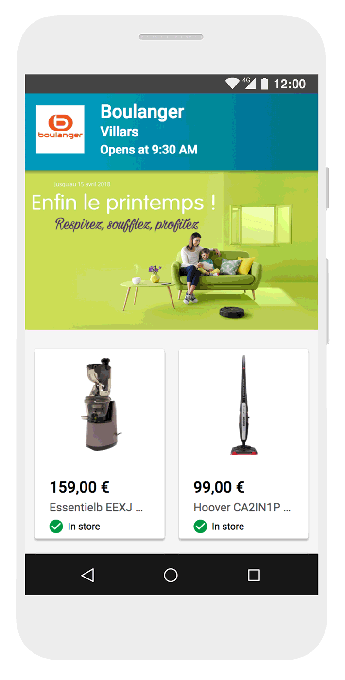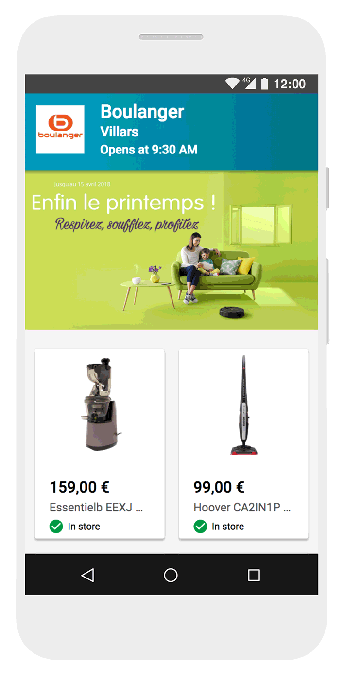Despite the growth of Amazon and other e-commerce giants, offline commerce — buying goods from brick-and-mortar stores — still accounts for around 90 percent of all retail spending. So in a bid to bridge the divide between online and in-store commerce — and potentially get itself a bigger piece of the action — Google is announcing a number of new features for Google Shopping aimed at physical and local merchants.
The company today launched a new feature called “See What’s In Store,” which will let physical stores provide a list of their inventory for free both in their Knowledge Panels (the boxes that appear in the right-hand column in the search results for a particular business) as well as on Google Maps.
The new feature was announced at the same time as a couple of other enhancements: Google will now provide location extensions on video campaigns on YouTube; and enhanced local catalog display ads that will let merchants feature larger “hero” images as well as full listings of their other in-store inventory, along with stock and pricing information.

The local catalog ads and inventory listings are coming by way of some new partnerships: Google will be working with point-of-sale and inventory data providers like Pointy, Cayan, Linx and yReceipts, who work directly with merchants, to provide the data to Google.
As one example of how this will work, Pointy — a startup from Mark Cummins, who sold his previous startup, a visual search engine called Plink, to Google in is first UK acquisition — is based around an app that integrates with POS services like Square, or a $499 standalone device, and merchants use these to scan items’ barcodes in order to upload them easily to their websites or other online portals with a minimum of extra labor and data entry; merchants will now have the option of porting that data directly to Google.
Providing more bridges between merchants and Google’s search and advertising portals serves a couple of different purposes for Google. First, it gives the company another springboard from which to sell more advertising to those merchants, since shoppers may be more inclined to enhance their online presence when they know they are already seeing traffic from potential buyers there.
According to a blog post on the new service from Surojit Chatterjee, Google Shopping’s head of product, some 80 percent of shoppers will visit a store if they know they will find there what they are looking for, so in theory providing that inventory list could increase that strike rate for businesses (or at the very least reduce frustration people may have when they do go to the store and find the product not there).
Second, it gives Google another way of providing a relevant platform for the so-called world of “omni-commerce,” or as some might refer to it, online-to-offline commerce, which in turn can drive more ad sales. Chatterjee said Boulanger, an early retailer trialling the new version of catalog ads, pictured above, drove more than 20,000 visits to its stores, with the sales bump resulting from that “delivering a return of 42 times its investment on ad spend.”
This is also particularly timely, given the work that Amazon is reportedly doing to expand the kinds of ads it delivers across third-party sites and apps: the e-commerce giant is said to be testing new display ads that would bypass Google to help promote products for merchants that sell through Amazon. Given that Amazon is also continually looking for inroads also to working with physical merchants, this presents one more threat to Google’s ad-based revenue model. It’s not the only move Google has made to expand its e-commerce reach. In its own riposte to WholeFoods and Amazon, it has started to work with grocery stores to sell their products online. The most recent customer for the service is Carrefour in France.
For the merchants, maintaining online an online presence via Google could also be helpful. Although some will still seek out a company’s own website or app, in many cases — especially for smaller businesses — maintaining these can be time-consuming and costly; and that’s before considering just how much traffic they might receive. Google, of course, provides a one-stop portal to search across everything, so this gives users a potentially bigger strike rate for online visibility.
The fact that the inventory will also come up in Maps is very interesting, too: aimed at consumers on the go, it could prove to finally solve the problem of running from place to place, or spending lots of time phoning, when a customer wants to buy something urgently.
Other Shopping features announced today include a new competitive pricing feature, which will let merchants check pricing for similar items sold by other retailers, and boost advertising bids if they know they have a better deal at their own store.
Google also provided an update on Shopping Actions, a program it launched in March for customers to be able to purchase items straight from search, Assistant or voice queries in Google apps. Google says that more than 70 retailers are live with the program today, which is also sold as an ad unit and runs as a conjunction to more basic Shopping ads.
Some argue that the efforts made here to improve how brick-and-mortar merchants are appearing online might just serve to lure more customers away from their stores, when they price compare and find lower costs for the same items in online stories. I’d argue that there is likely still a large market for those brick-and-mortar merchants, particularly with people who still prefer to see items in person before they buy, or want to travel to buy items without waiting for them to come by delivery.

